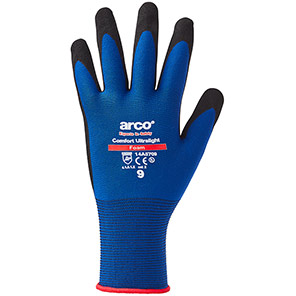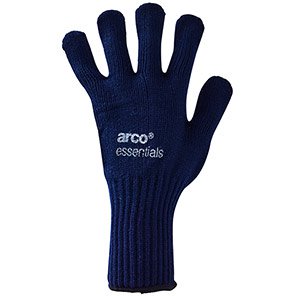Each standard details what tests should be completed and how. Using the results of testing, they also state what level of protection can be quoted on gloves to help users select appropriate ones for their application.
About Each Glove Standard
How gloves are tested to ensure they protect
EN 21420:2020 - General Requirements for Protective Gloves
This standard is designed to ensure that gloves are comfortable and don't themselves harm wearers and is now aligned with REACH regulations.
- Gloves must not adversely affect users' hygiene or health. For example, they should be pH neutral and chromium (chrome VI) content has to be minimal
- Any substance used in gloves known to cause allergies must be stated on packaging - a specific test for latex content should be undertaken
- Seams shouldn't reduce the performance of gloves
- Gloves need to be sized using the common European hand size and their effect on finger dexterity has to be assessed
- Information to allow traceability and expiry dates need to be included for users
EN 388:2016 - Protective Gloves Against Mechanical Risks
This standard determines a glove's performance against physical hazards when handling rough or sharp objects, such as thin metal sheet, glass or masonry blocks. Watch our video to see the tests for yourself.
EN 388 includes a series of up to six separate tests which measure gloves' level of resistance to abrasion, cutting, tearing, puncture and where relevant, impact.
- The abrasion resistance of gloves is determined by how quickly a glove's fabric wears through when its rubbed using a Martindale Abrasion Tester
- The two blade cut resistance tests assess how well gloves protect against sharp objects. The Coupe test has its limitations, so we recommend referring only to the ISO 13997 result whenever selecting gloves for medium or high risk cut environments
- Tear resistance is determined by the degree of force needed to rip the glove's fabric
- The puncture resistance test measures the force needed to pierce the gloves' fabric using a nail/stylus. If protection against sharper points such as needles is needed, then refer to the needlestick test result ASTM F2878
- The impact resistance test determines how much impact energy a glove dissipates. This test is optional, as only gloves specifically designed with impact resistant properties will reduce forces to a safe level
EN 374:2016 - Protective Gloves Against Dangerous Chemicals and Micro-Organisms
This standard evaluates a glove's ability to protect against both dangerous chemicals and micro-organisms using a number of tests.
A simple air or a water leakage test measures a glove's resistance to penetration - the flow of test chemical through its seams, porous materials, pinholes or other imperfections in the glove. A number of gloves need to be tested from a given batch to demonstrate consistent protection.
If a glove passes both the air and water penetration test, then it can also claim protection against bacteria and fungi. However, protection against viruses needs to be proven using an additional test. Gloves need to demonstrate no detectable transfer of a surrogate virus - Phi-X174 bacteriophage - through the glove material, as described in ISO 16604.
The more stringent aspect of the standard is measurement of a glove's permeation performance - or how long it takes for a hazardous chemical to pass or 'break' through the glove's material at a molecular level.
Gloves are classified as Type A, B or C depending upon how many chemicals the gloves perform against from a set list of 18 chemicals. If gloves have been tested with additional chemicals, information about the performance levels may be provided in the user instructions.
Gloves are classified as type B if they comply with a permeation performance of at least level two but for only three to five chemicals.
Gloves achieve this if they pass level one - breakthrough time of at least 10 minutes - against a single chemical. Type C gloves are designed for low chemical risks.
Any changes observed in the physical appearance of a glove specimen, due to the glove materials being degraded by the chemical over time, are reported separately in the user information leaflet. Physical changes might include:
- Swelling
- Shrinking
- Brittleness
- Hardening
- Softening
- Flaking
- Disintegration
- Colour change
- Colour bleeding
- Separation of the glove's layers
EN 407:2020 - Protection from Thermal Hazards (Heat and/or Fire)
This standard measures the protection gloves provide against different types of thermal hazards, and so their ability to reduce workers risk of sustaining burn injuries. To be EN 407 certified, gloves also need to provide low level protection against abrasion and tear - as tested in EN 388:2016.
The standard includes six separate thermal tests:
- Gloves' behaviour when in contact with a flame is used to determine their flammability
- Contact heat resistance assesses how hot an item can be without the wearer feeling pain when holding it, by measuring the temperature inside the glove
- Convective heat resistance is assessed based on how long gloves delay the transfer of heat from a flame
- Radiant heat resistance is also based on the time gloves can prevent heat, but from a radiant heat source
- Resistance to small splashes of molten metal is assessed by measuring the number needed to heat up the glove
- Resistance to large splashes of molten metal is measured by the weight of metal which damages simulated skin behind the glove
EN 12477:2001 - Protective Gloves for Welders
Gloves which have achieved specific scores in EN 407 and EN 388 standard tests can be recommended for welding applications. They are graded as providing either Class A or Class B protection.
- Type A gloves offer more protection and are intended for more general welding processes
- Type B gloves are more suited to welding operations that need good dexterity
| Minimum Level Required | |||
|---|---|---|---|
| Performance Test | Type A | Type B | |
| EN 388 | Abrasion | 2 | 1 |
| EN 388 | Cut | 1 | 1 |
| EN 388 | Tear | 2 | 1 |
| EN 388 | Puncture | 2 | 1 |
| EN 407 | Burning behaviour | 3 | 2 |
| EN 407 | Contact heat | 1 | 1 |
| EN 407 | Convective heat | 2 | - |
| EN 407 | Small splashes of molten metal | 3 | 2 |
| EN 420 | Dexterity | 1 | 4 |
EN 511:2006 - Gloves Giving Protection from Cold
This applies to any gloves intended to protect the hands against cold environments down to - 50 °C. It measures the gloves' resistance to three different types of cold hazard.
- Convective cold transferred by the glove is an indication of its insulation properties
- The thermal properties of gloves are assessed when in contact with a cold object
- Water permeability is assessed after 30 minutes. If a glove fails this test, then users must be informed that they may lose their insulative properties when wet
Gloves also need to provide low level protection against abrasion and tear - as tested in EN 388 standard.
EN 10819:2013 - Gloves Giving Protection from Vibrations - Vibration Attenuation
Test results show the vibration transmissibility of gloves which incorporate vibration-reducing materials covering the palm, fingers, and thumb of the hand.
Gloves should not enhance vibrations with a moderately strong frequency (of 31.5 Hz to 200 Hz) from a handle through a glove to the palm of the hand. At a high frequency (of 200 Hz to 1,250 Hz), the gloves need to reduce the average level of vibration by 40%.
EN 421:2010 - Radioactive Contamination and Ionising Radiation
To ensure protection from radioactive contamination, gloves must be liquid proof, passing the EN 374 standard penetration test. If the glove is being used in containment enclosures, it also needs to pass a specific air pressure leak test to demonstrate high resistance to permeability of water vapour.
To protect from ionising radiation, gloves have to contain an amount of lead or appropriate metal (quoted as lead equivalence).
A material's response to ozone mimics its behaviour when exposed to ionising radiation so results of this test can optionally be used as an aid to selecting gloves.
EN 16350:2014 - Electrostatic Properties
Gloves with antistatic properties are intended to dissipate electrostatic build-up to avoid electrostatic discharges and so to minimize explosion risks. This standard specifies the design requirements and test methods to assess them. Surface resistivity along the surface of the gloves' material measures the degree that charge builds-up.
This is important for gloves that are worn in areas where flammable or explosive areas may exist, but does not include assessment of gloves ability to protect electronic devices or against mains voltages, live working (EN 60903) or welding hazards (EN 12477).
EN 60903:2003 - Gloves of Insulating Material for Live Working.
Electrical safety gloves are categorised by the level of voltage protection they provide. The nature of the work being undertaken will determine the most appropriate choice.
| Gloves class | Maximum AC use | Maximum DC use from Withstand test//Volts |
|---|---|---|
| Class 00 | 500 | 750 |
| Class 0 | 1,000 | 1,500 |
| Class 1 | 7,500 | 11,250 |
| Class 2 | 17,000 | 25,500 |
| Class 3 | 26,500 | 39,750 |
| Class 4 | 36,000 | 54,000 |
A letter is used to indicate any additional protective properties that the gloves are certified, for example resistance against sulfuric acid (A), oil (H), ozone (Z) and low temperatures of -25 °C (C). Category R gloves are acid, oil and ozone resistant.
EN 1186:2002 - Contact with Food Test Method
Plastic items which are intended to come into contact with food should not transfer substances which could either endanger human health or cause unacceptable changes in the food. Therefore, only gloves that are food contact approved should be used when handling food.
Food approval is granted if gloves conform to the European Framework Regulations 1935/2004 and these tests demonstrate minimal transfer from them into a food replica.
- The Overall Migration Limit (OML) is the maximum permitted cumulative amount of non-volatile substances that can be released into the food
- The Specific Migration Limit (SML) evaluates specific substances identified in toxicological studies, replicating the worst foreseeable conditions the gloves may be used in
For both specific and overall migration, a glove intended for repeat use is tested three times, using fresh simulant to replicate food each time. Compliance is based on the outcome of the third test.
More from Arco

Product Selection
Selecting gloves that protect workers can be crucial in helping to keep their hands safe, but often wearing gloves makes tasks easier and more efficient too. From chemical resistant gloves to multipurpose gloves, we can help you select the right products.

Advice and Support
Whether you need validation of the current gloves in use at your workplace, help with cost down initiatives, or recommendations for new safety procedures to keep up with changing legislation, Arco can help.
Recommended Products
Hand protection designed for a variety of industries, applications and hazards, ensuring you can find a glove that's perfectly matched to your needs.
















